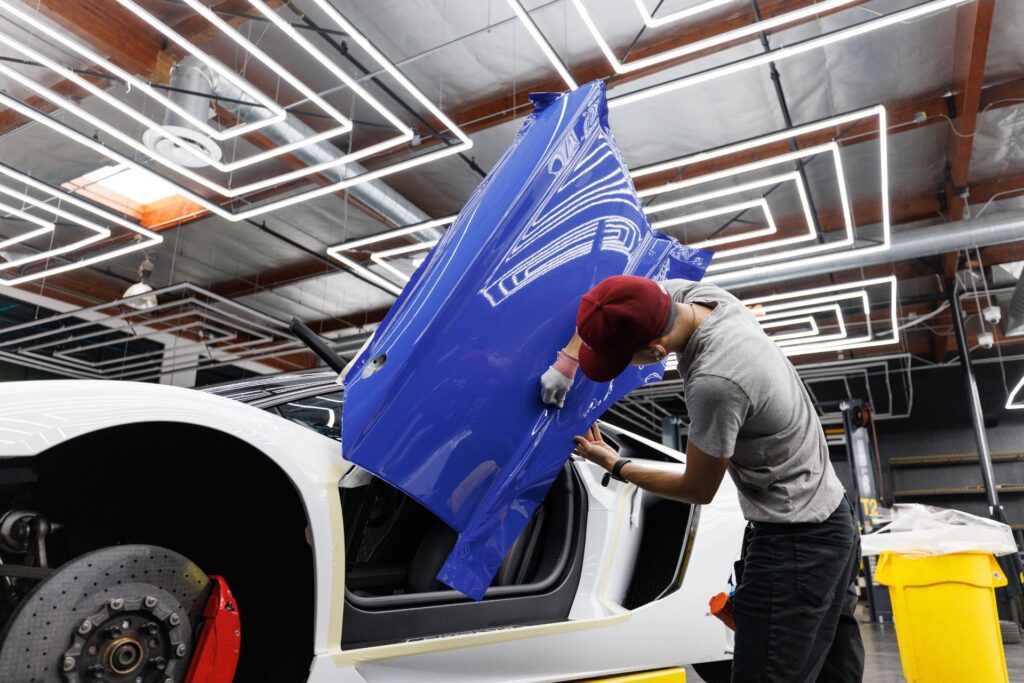TL;DR:
Choosing whether to wrap or paint your car depends on your budget, desired look, and how long you want the finish to last. A basic paint job can be cheaper than a vinyl wrap, but higher-end paint can cost more than even premium wrapping. Car wraps offer flexibility, easier maintenance, and temporary style changes, while paint jobs can provide a permanent, high-quality finish that may boost resale value. Ultimately, evaluate your car’s condition, compare quotes, and consider long-term maintenance before deciding.
Introduction
Choosing between painting or wrapping your car is often a balancing act of budget, durability, and style. Both methods offer distinct advantages, yet costs can vary significantly based on factors like the quality of materials used, the complexity of your car’s design, and labor expenses. In this article, we’ll explore whether it’s cheaper to wrap or paint a car, break down the financial considerations, and help you decide which option is best for you.

Understanding the Difference Between Car Wrapping and Painting
What is a Car Wrap?
A car wrap typically uses vinyl sheets applied directly over your vehicle’s existing paintwork. This process creates a protective and decorative layer that can be removed later without damaging the paint underneath—assuming the original paint is in good condition.
Common Types of Vinyl Wraps
- Matte Wraps: Give a flat, non-reflective appearance.
- Gloss Wraps: Mimic the shine of a painted surface.
- Textured Wraps: Offer unique finishes like carbon fiber or brushed metal.
What is Car Painting?
Car painting, or auto repainting, involves applying multiple coats of paint and sealant to your vehicle’s body. It can completely refresh the look of an older car or change the color of a newer one.
Levels of Car Paint Quality
- Basic Paint Jobs: Inexpensive, limited prep work, lower-quality paint.
- Mid-Level Paint Jobs: Better paint quality and prep work, often cost more.
- High-End Paint Jobs: Involve premium paints, extensive prep, and a flawless finish.
Cost Factors to Consider
Vinyl Wrap Costs
- Material Quality: The price of vinyl varies depending on brand, thickness, and finish.
- Labor Complexity: Intricate designs, custom graphics, and cars with more curves or edges can increase labor fees.
- Durability and Lifespan: Wraps typically last 3–5 years. Replacing damaged panels can be cheaper than repainting an entire car, but it is still an expense to consider.
Car Paint Costs
- Type of Paint and Finish: Urethane paints, acrylic paints, and metallic finishes have different price points.
- Prep Work: Surface repair (like dent removal or rust treatment) can add to the overall cost.
- Professional vs. DIY: Hiring a professional ensures a high-quality finish but comes with higher labor costs.
Comparing Prices: Is It Cheaper to Wrap or Paint a Car?
Typical Price Ranges
- Professional Car Wrap: Ranges from $2,000 to $7,000, depending on vinyl quality, color choices, and the size of your vehicle.
- Professional Paint Job: Varies widely from $1,000 to $10,000 or more, influenced heavily by the quality of paint, prep work, and labor rates.
In many cases, a basic paint job can be cheaper than a vinyl wrap. However, high-quality paint jobs can cost significantly more than even the most premium vinyl wraps. The final price depends on your desired outcome and the condition of your car.
Maintenance and Long-Term Costs
- Car Wrap Maintenance: Relatively easy; washing with gentle soap helps preserve vinyl. Avoiding harsh chemicals or abrasive brushes is key. If a section is damaged, it can be replaced individually.
- Paint Maintenance: Requires regular waxing and proper washing techniques to maintain shine. Chips or scratches might require professional touch-ups or partial repainting.
Pros and Cons of Wrapping vs. Painting
Advantages of Wrapping
- Lower Upfront Cost (in many cases): Mid-range wraps can be cheaper than higher-end paint jobs.
- Variety and Customization: Vinyl can accommodate patterns, textures, and finishes that are more expensive or difficult with paint.
- Protection for Original Paint: Wraps act as a shield, preserving the original finish.
Disadvantages of Wrapping
- Limited Lifespan: Most wraps last a few years before needing replacement.
- Quality Variation: Cheaper vinyl can fade or peel quickly.
Advantages of Painting
- Permanent Finish: A professionally applied paint job can last for many years with proper maintenance.
- Higher Resale Value (in some cases): A quality paint job can enhance the car’s overall value if done with attention to detail.
- Color Depth and Shine: Premium paint can achieve a deeper, more vibrant finish.
Disadvantages of Painting
- Higher Potential Cost: Premium paint jobs can be significantly more expensive than wraps.
- Longer Downtime: Paint jobs require curing and drying, potentially leaving you without your car for days or weeks.
- Maintenance Needs: Scratches and chips are more costly to repair than minor vinyl damage.
How to Make the Best Choice for Your Budget
- Assess the Car’s Current Condition: If the paint is heavily damaged, wrapping may not adhere well. Painting might be a better first step.
- Set a Realistic Budget: Decide how much you’re willing to invest in either wrapping or painting.
- Consider Your Long-Term Goals: If you’re seeking a short-term color change, a wrap can be removed later. If you want a permanent transformation, painting is a solid option.
- Get Multiple Quotes: Compare different shops for both paint and wrap services. Quality and pricing can vary dramatically.
- Factor in Maintenance Costs: Think about how much time and money you’re willing to spend on upkeep.
Conclusion
In many cases, a standard car wrap can be cheaper than a premium paint job, while a basic paint job might be less expensive than a high-quality wrap. It all comes down to personal preference, the car’s condition, and how long you plan to keep the new finish. By weighing factors like budget, customization needs, and durability, you can confidently decide whether it’s cheaper to wrap or paint your car—and more importantly, which option best suits your style and goals.
By understanding the true cost of both wrapping and painting a car—and factoring in materials, labor, and long-term maintenance—you can make the smartest choice for your vehicle and your wallet.
